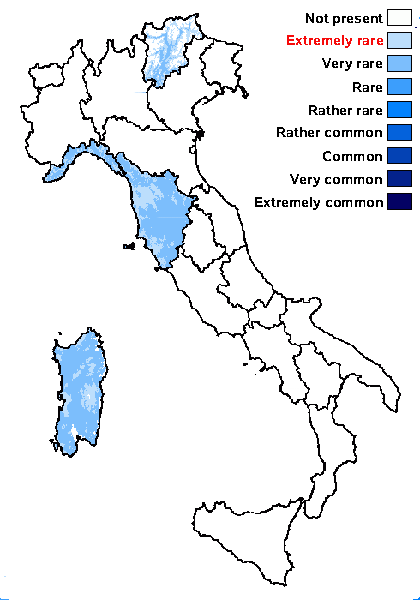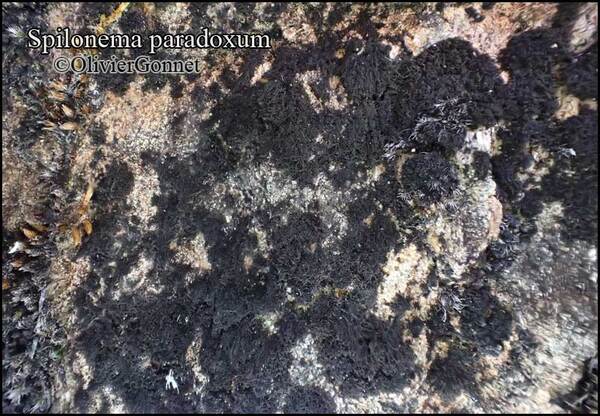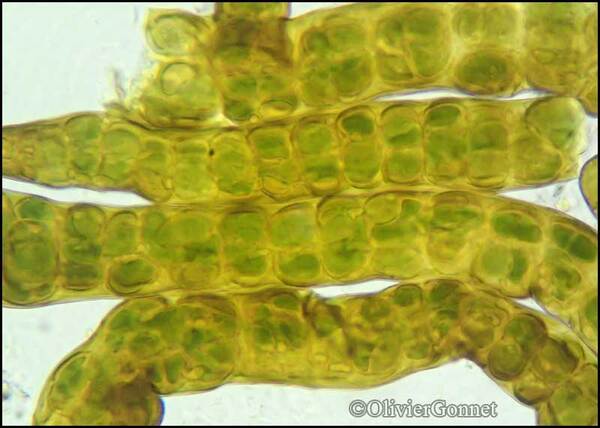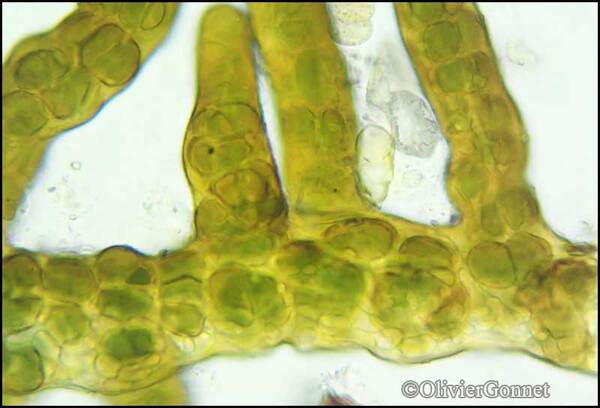Spilonema paradoxum Bornet
Mém. Soc. Imp. Sc. Nat. Cherbourg, 4: 225, 1856.
Synonyms: Spilonema pannosum Hy; Spilonema tenellum Vain.
Distribution: N - TAA, Lig. C - Tosc (Ravera & al. 2025), Sar (TSB 13292).
Description: Thallus minutely filamentous, blackish, forming irregular, flattened, up to 2 cm wide mats, the filaments loosely interwoven, prostrate, up to 4 mm long and to 40 µm thick, branched perpendicularly to the main axis, with blue-green rhizohyphae at the base, consisting of 1- or 2-seriate cyanobacterial trichomes surrounded by a gelatinous sheath permeated (except at the tips of filaments) with a network of fungal hyphae; outer hyphae giving rise to thinner hyphae which penetrate among the cyanobacterial cells. Apothecia rare, biatorine, (0.2-)0.5-1 mm across, arising at the tip of short, thickened lateral branches, with a convex disc, immarginate. Proper exciple thin, of radially arranged hyphae; hymenium 55-65 µm high, pale violet in upper part, I+ blue; paraphyses thick, branched; hypothecium colourless, paraplectenchymatous. Asci 8-spored, cylindrical, thick-walled, with a K/I+ blue apical thickening. Ascospores 1-celled, hyaline, ellipsoid or slightly kidney-shaped, 7-9 x 2-3 µm, the wall green-black, N+ red. Pycnidia wart-like, to 0.2 mm in diam., the wall green-black, N+ red, the conidiogenous cells short, catenate. Conidia acrogenous and pleurogenous, simple, hyaline, short-bacilliform, 2-4 x c. 1 µm. Photobiont cyanobacterial (Stigonema), the cells c. 9-15 x 9-13 µm. Spot tests: all negative. Chemistry: without lichen substances.Note: a widespread lichen found on sun-exposed, inclined to vertical seepage tracks of basic siliceous rocks below the subalpine belt; perhaps overlooked, but certainly not common in Italy.
Growth form: Crustose
Substrata: rocks
Photobiont: cyanobacteria, filamentous (e.g. Nostoc, Scytonema)
Reproductive strategy: mainly sexual
Subcontinental: restricted to areas with a dry-subcontinental climate (e.g. dry Alpine valleys, parts of Mediterranean Italy)
On otherwise dry surfaces with short periods of water seepage after rain
Commonnes-rarity: (info)
Alpine belt: absent
Subalpine belt: absent
Oromediterranean belt: absent
Montane belt: extremely rare
Submediterranean belt: very rare
Padanian area: absent
Humid submediterranean belt: very rare
Humid mediterranean belt: extremely rare
Dry mediterranean belt: absent

Predictive model
Herbarium samples

Courtesy Danièle et Olivier Gonnet - Source: https://www.afl-lichenologie.fr/Photos_AFL/Photos_AFL_S/Text_S/Spilonema_paradoxum.htm
France, stage micro de nov. 2015 - Saint-Prejet-Armandon - Haute-Loire - (43) - sur rocher à serpentine

Courtesy Danièle et Olivier Gonnet - Source: https://www.afl-lichenologie.fr/Photos_AFL/Photos_AFL_S/Text_S/Spilonema_paradoxum.htm
France, stage micro de nov. 2015 - Saint-Prejet-Armandon - Haute-Loire - (43) - sur rocher à serpentine

Courtesy Danièle et Olivier Gonnet - Source: https://www.afl-lichenologie.fr/Photos_AFL/Photos_AFL_S/Text_S/Spilonema_paradoxum.htm
France, stage micro de nov. 2015 - Saint-Prejet-Armandon - Haute-Loire - (43) - sur rocher à serpentine
Growth form: Crustose
Substrata: rocks
Photobiont: cyanobacteria, filamentous (e.g. Nostoc, Scytonema)
Reproductive strategy: mainly sexual
Subcontinental: restricted to areas with a dry-subcontinental climate (e.g. dry Alpine valleys, parts of Mediterranean Italy)
On otherwise dry surfaces with short periods of water seepage after rain
Commonnes-rarity: (info)
Alpine belt: absent
Subalpine belt: absent
Oromediterranean belt: absent
Montane belt: extremely rare
Submediterranean belt: very rare
Padanian area: absent
Humid submediterranean belt: very rare
Humid mediterranean belt: extremely rare
Dry mediterranean belt: absent

Predictive model
| Herbarium samples |

Courtesy Danièle et Olivier Gonnet - Source: https://www.afl-lichenologie.fr/Photos_AFL/Photos_AFL_S/Text_S/Spilonema_paradoxum.htm
France, stage micro de nov. 2015 - Saint-Prejet-Armandon - Haute-Loire - (43) - sur rocher à serpentine

Courtesy Danièle et Olivier Gonnet - Source: https://www.afl-lichenologie.fr/Photos_AFL/Photos_AFL_S/Text_S/Spilonema_paradoxum.htm
France, stage micro de nov. 2015 - Saint-Prejet-Armandon - Haute-Loire - (43) - sur rocher à serpentine

 INDEX FUNGORUM
INDEX FUNGORUM
 GBIF
GBIF
 DOLICHENS
DOLICHENS





